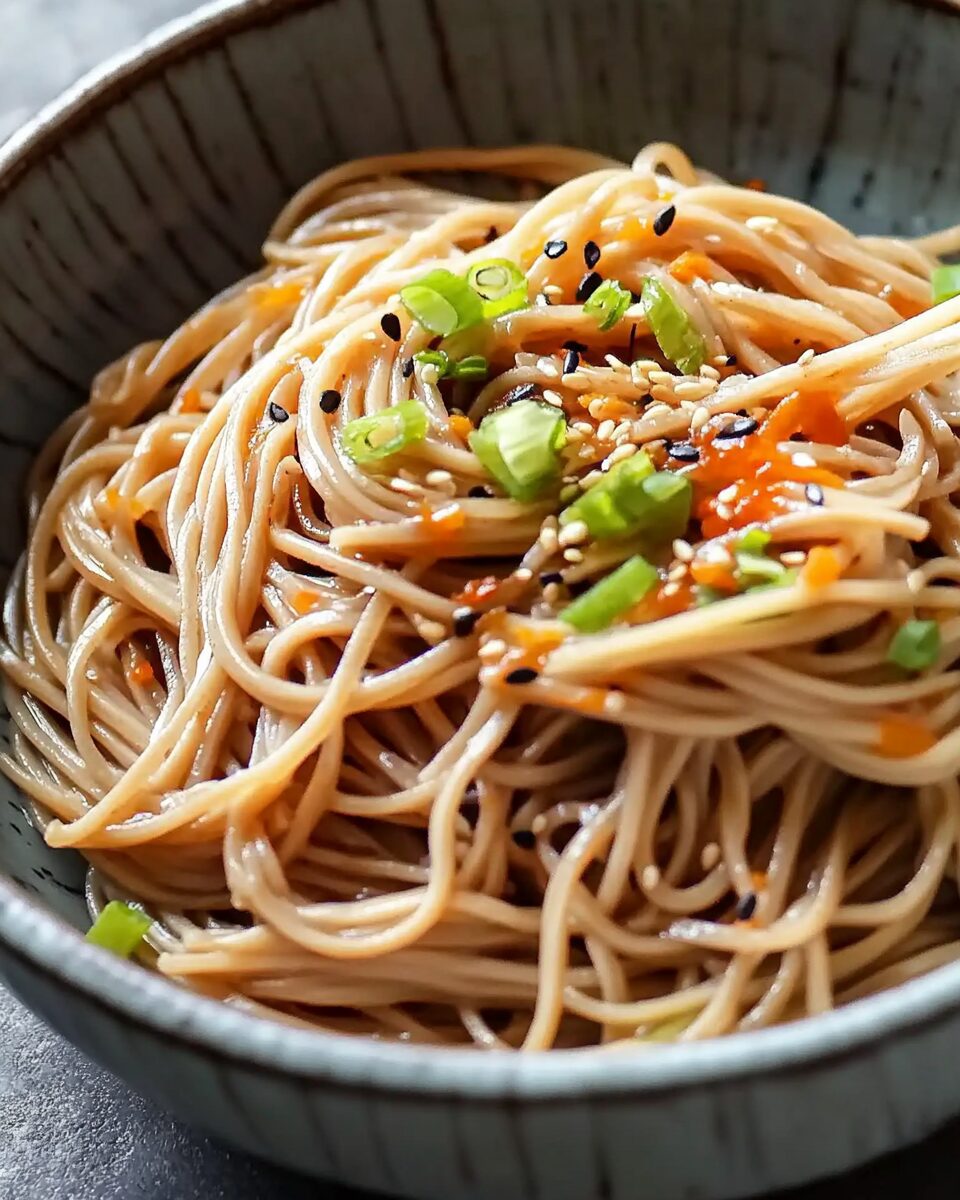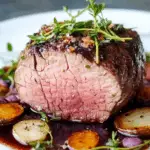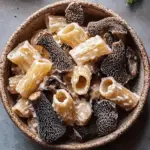These spicy cold soba noodles are a refreshing and flavorful dish, perfect as a side or light meal. Adjust the heat by modifying the amount of chili oil, and consider adding tofu, chicken, or shrimp for added protein.
Full Recipe:
Ingredients
- ⅔ cup soy sauce
- 2 tablespoons molasses
- ½ cup sesame oil
- ½ cup tahini paste
- 6 tablespoons balsamic vinegar
- 2 tablespoons chili oil, or more to taste
- ½ cup sliced scallions, divided
- 1 pound dried soba noodles
- 1 tablespoon sesame seeds
Directions
-
Prepare the Soy Sauce Reduction: Bring soy sauce to a boil in a small saucepan over medium-high heat. Reduce heat to medium-low and simmer until reduced by half, about 10 to 15 minutes. Remove from heat and stir in molasses.
-
Make the Dressing: In a bowl, whisk together sesame oil, tahini, balsamic vinegar, and chili oil. Slowly incorporate the soy sauce reduction, then stir in ¼ cup of the sliced scallions.
-
Cook the Soba Noodles: Bring a large pot of lightly salted water to a boil. Cook soba noodles in boiling water, stirring occasionally, until tender yet firm to the bite, approximately 3 minutes. Drain immediately and rinse thoroughly with cold water to cool.
-
Combine and Chill: Toss the cooled noodles with the dressing. Sprinkle the remaining ¼ cup of scallions and sesame seeds on top. Refrigerate until cold, at least 30 minutes, before serving.
Nutritional Facts (per serving)
- Calories: 466
- Total Fat: 25g
- Saturated Fat: 4g
- Sodium: 1,675mg
- Total Carbohydrates: 53g
- Dietary Fiber: 2g
- Total Sugars: 5g
- Protein: 12g
The History and Cultural Significance of Soba Noodles
Soba noodles have been a fundamental part of Japanese cuisine for centuries. Made from buckwheat flour, these thin noodles have a distinct earthy taste and offer a wealth of health benefits. Historically, soba has been enjoyed both hot and cold, with cold soba dishes often served during the summer months to provide a cooling effect.
Soba is deeply rooted in Japanese culinary traditions, with origins dating back to the Edo period (1603–1868). Initially considered a luxury food for the aristocracy, soba eventually became a popular street food and household staple. In Japan, eating soba on New Year’s Eve, known as “Toshikoshi Soba,” is a long-standing tradition symbolizing longevity and good fortune.
While traditional zaru soba is served with a simple dipping sauce, modern variations like spicy cold soba noodles add layers of flavor with bold seasonings, oils, and fresh toppings. Today, soba is widely enjoyed across the globe, with many restaurants and home cooks experimenting with innovative flavors and ingredients to create new and exciting dishes.
What Makes Spicy Cold Soba Noodles Unique?
Unlike many noodle dishes that are served warm, spicy cold soba noodles provide a refreshing alternative that highlights the versatility of soba. The combination of cool noodles with a spicy, umami-rich sauce creates a unique balance of flavors that awaken the palate. This dish is perfect for those who enjoy bold spices without the heaviness of a hot meal.
One of the key elements that set this dish apart is the dressing. Typically made with ingredients like soy sauce, sesame oil, tahini, balsamic vinegar, and chili oil, the sauce offers an enticing mix of salty, nutty, tangy, and spicy notes. The addition of garnishes such as scallions and sesame seeds further enhances the overall experience, providing extra texture and depth.
Another reason why this dish stands out is its adaptability. It can be enjoyed as a standalone meal or customized with various toppings, making it an excellent option for different dietary preferences.
Health Benefits of Soba Noodles
Soba noodles are not only delicious but also packed with nutritional benefits. Unlike refined wheat-based pasta, soba noodles are traditionally made from buckwheat, which is naturally gluten-free and rich in essential nutrients. Some of the key health benefits of soba noodles include:
- High in Protein: Buckwheat contains all nine essential amino acids, making it a complete protein source, which is particularly beneficial for vegetarians and vegans.
- Rich in Fiber: Soba noodles provide a good amount of dietary fiber, aiding in digestion and promoting gut health.
- Supports Heart Health: Buckwheat is known to help lower cholesterol levels and improve circulation, reducing the risk of cardiovascular diseases.
- Gluten-Free Option: While some soba noodles may be mixed with wheat flour, pure buckwheat soba is an excellent gluten-free choice for those with sensitivities.
- Low in Calories: Soba noodles are relatively low in calories compared to traditional pasta, making them a great option for weight-conscious individuals.
The sauce in this dish also contributes to its health benefits. Sesame oil and tahini provide healthy fats, while soy sauce adds a dose of umami without the need for excessive salt. The inclusion of chili oil can also boost metabolism and provide anti-inflammatory benefits.
Flavor Profile and Ingredients
Spicy cold soba noodles are known for their harmonious blend of flavors. The key elements that contribute to the dish’s unique taste include:
- Umami: The soy sauce and tahini give the dish a deep, savory taste that enhances the natural flavor of the soba noodles.
- Spice: Chili oil adds a fiery kick that can be adjusted to personal preference.
- Nutty: Sesame oil and sesame seeds add a rich, toasty undertone.
- Tangy: The balsamic vinegar provides a slight acidity that balances the richness of the sauce.
- Freshness: Scallions, cucumbers, and other optional vegetables add a crisp, refreshing contrast.
Each ingredient in this dish plays an essential role in achieving the perfect balance of flavors.
Ideal Pairings and Serving Suggestions
Spicy cold soba noodles can be enjoyed on their own or paired with complementary dishes for a more complete meal. Some great pairing ideas include:
- Protein Additions: Grilled tofu, shrimp, shredded chicken, or soft-boiled eggs can enhance the dish with added protein.
- Vegetable Toppings: Fresh cucumber, shredded carrots, radish, and edamame can provide additional crunch and nutrition.
- Soup Accompaniments: A light miso soup or a simple vegetable broth pairs well with the refreshing qualities of the soba noodles.
- Side Dishes: Serve alongside Japanese-style pickles, seaweed salad, or steamed dumplings for a well-rounded meal.
For added crunch, toasted seaweed strips or crushed peanuts can be sprinkled on top. Those who enjoy a citrusy touch can add a splash of lime or yuzu juice to the sauce.
When to Enjoy Spicy Cold Soba Noodles
This dish is an excellent choice for a variety of occasions. It can be served as a quick and easy lunch, a light dinner, or a refreshing meal on a hot summer day. It’s also a fantastic dish for meal prepping, as the flavors intensify when left to marinate in the refrigerator. Additionally, it’s a great option for picnics, potlucks, and gatherings, as it can be served chilled and does not require reheating.
Tips for Perfect Spicy Cold Soba Noodles
- Use High-Quality Soba: Look for soba noodles made with 100% buckwheat flour for the best texture and flavor.
- Rinse the Noodles Well: After cooking, rinse soba noodles under cold water to remove excess starch and prevent them from becoming gummy.
- Adjust Spice Levels: If you’re sensitive to spice, start with a small amount of chili oil and gradually increase it.
- Let the Flavors Marinate: Allow the noodles to chill in the refrigerator for at least 30 minutes before serving to let the flavors meld.
- Experiment with Toppings: Get creative with your toppings to add different textures and flavors.
Conclusion
Spicy cold soba noodles are a flavorful, refreshing, and nutritious dish that showcases the versatility of buckwheat noodles. With their balanced combination of heat, umami, and refreshing textures, they are a fantastic addition to any meal plan. Whether you enjoy them as a standalone dish or pair them with proteins and vegetables, these noodles provide a satisfying and health-conscious dining experience.






